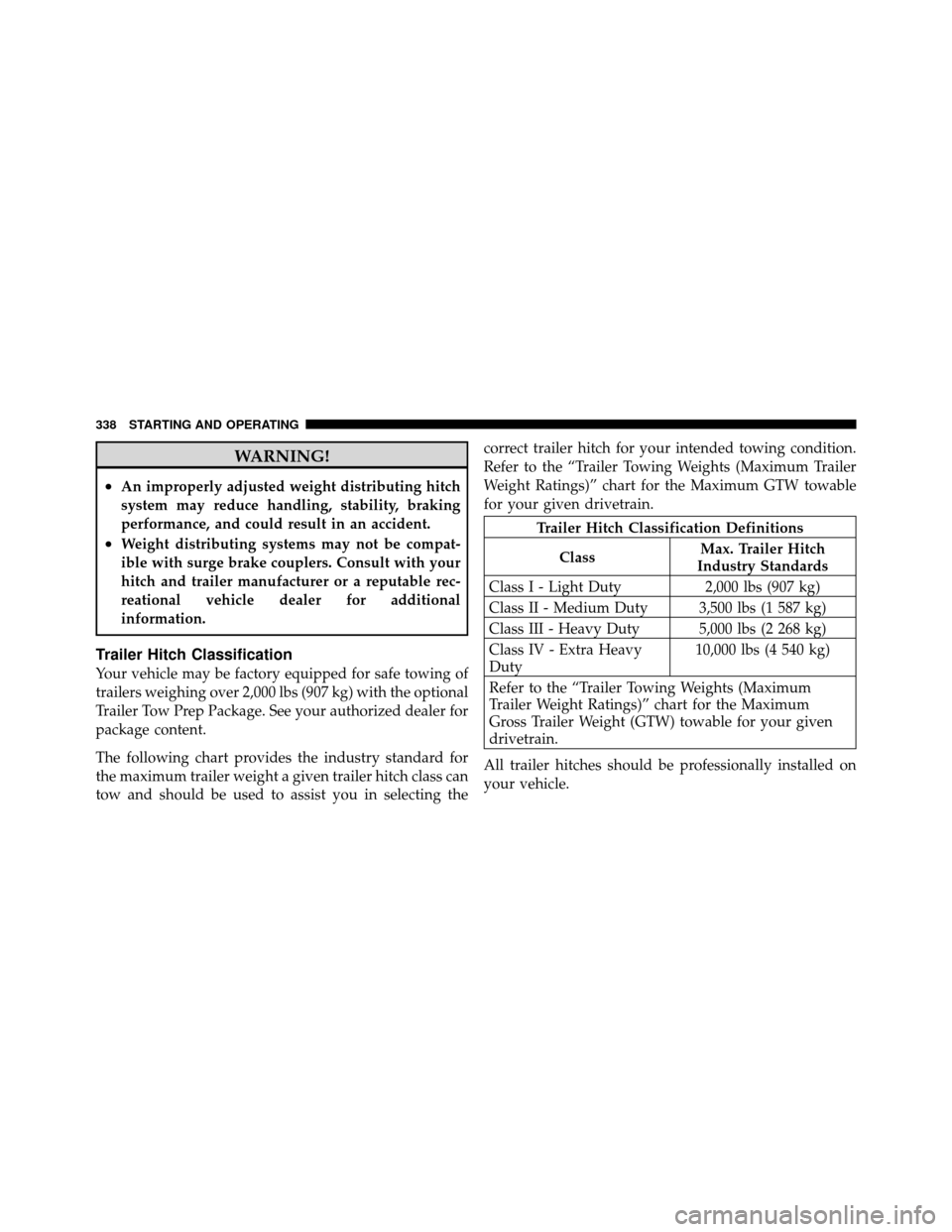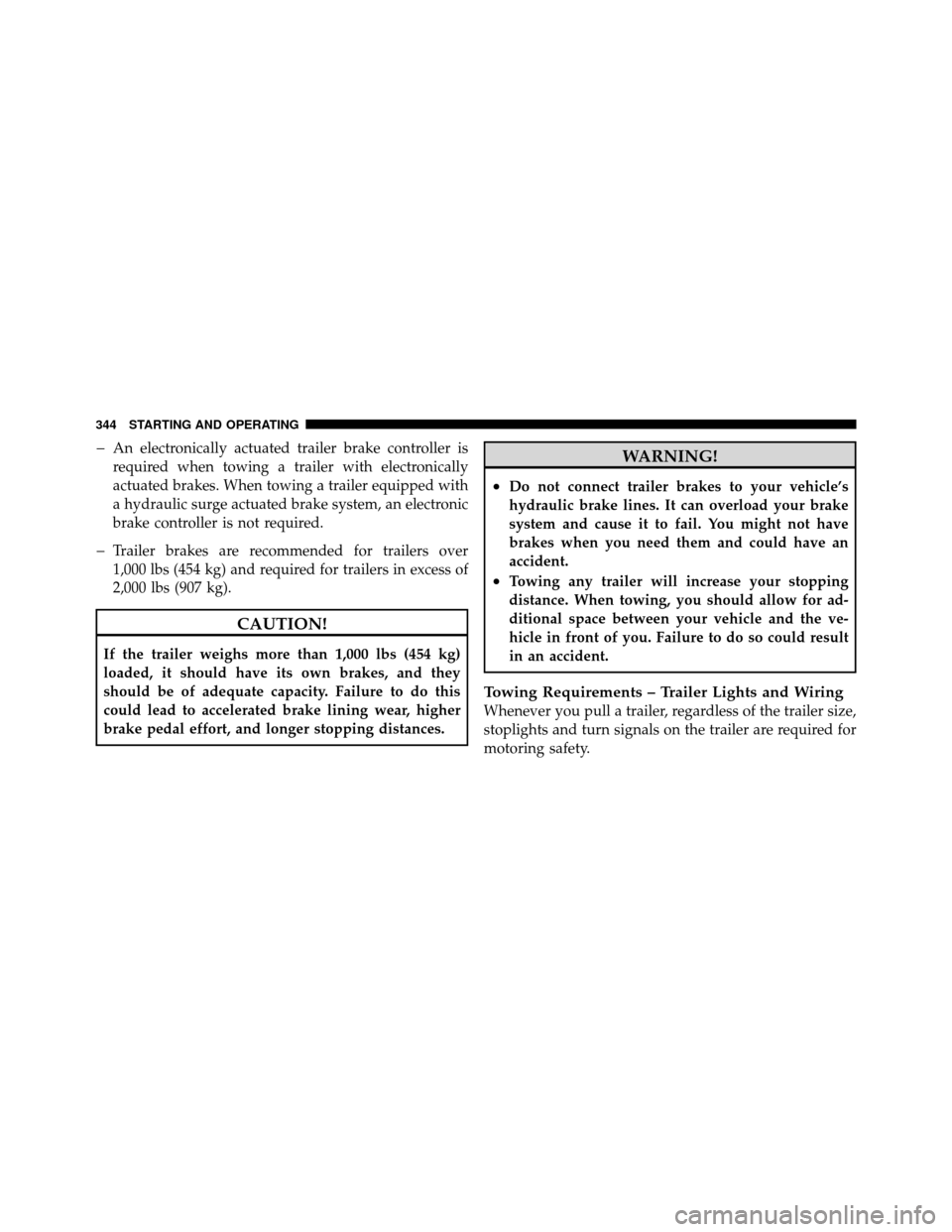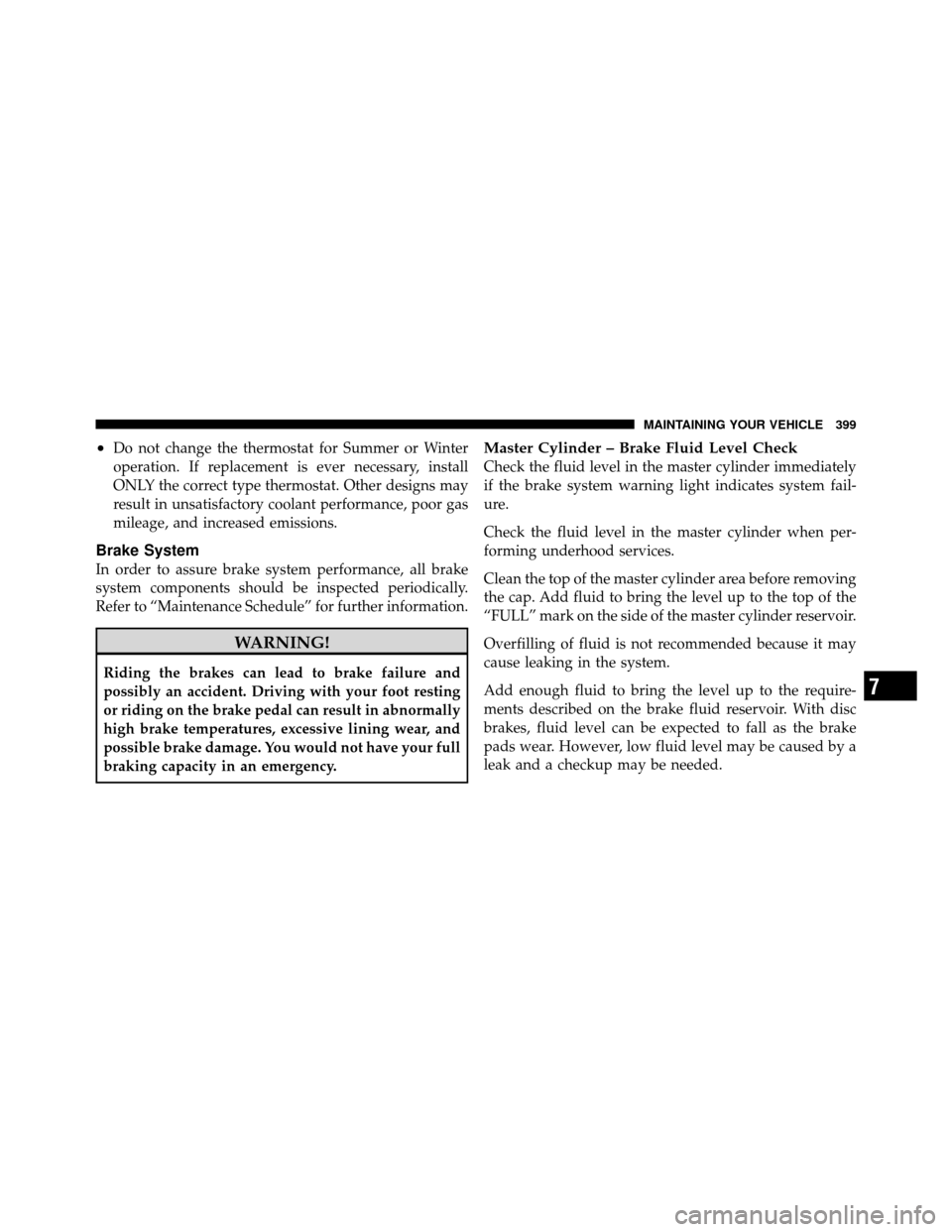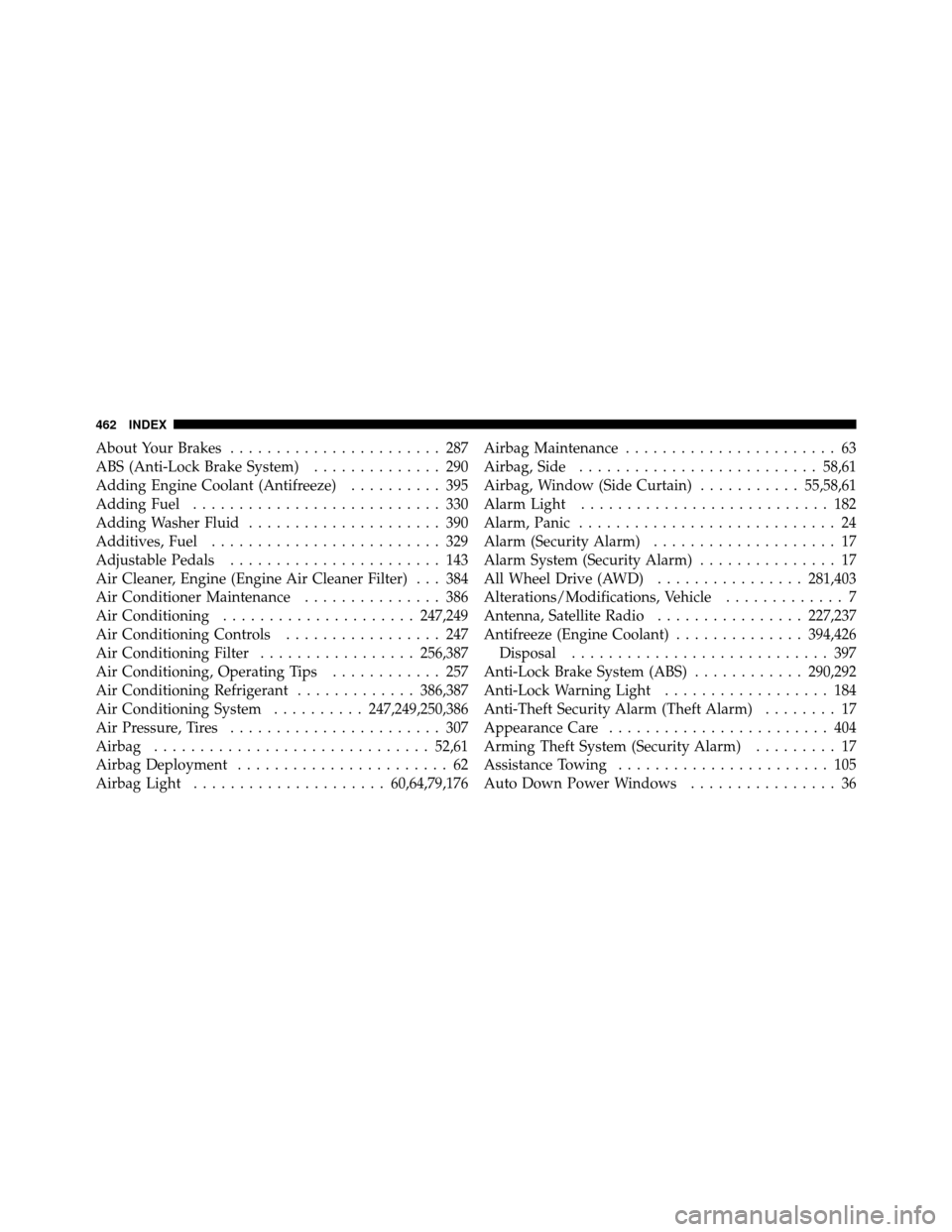Page 295 of 484

power may also be reduced to assist in counteracting the
condition of oversteer or understeer and help the vehicle
maintain the desired path.
The ESP uses sensors in the vehicle to determine the path
that the driver intends to steer the vehicle and compares
it to the actual path of the vehicle. When the actual path
does not match the intended path, the ESP applies the
brake of the appropriate wheel to assist in counteracting
the condition of oversteer or understeer.
•Oversteer - when the vehicle is turning more than
appropriate for the steering wheel position.
•Understeer - when the vehicle is turning less than
appropriate for the steering wheel position.The “ESP/TCS Indicator Light” located in the
instrument cluster, starts to flash as soon as the
tires lose traction and the ESP system becomes
active. The “ESP/TCS Indicator Light” also flashes when the TCS is active. If the “ESP/TCS Indicator
Light” begins to flash during acceleration, ease up on the
accelerator and apply as little throttle as possible. Be sure
to adapt your speed and driving to the prevailing road
conditions.
WARNING!
The ESP cannot prevent the natural laws of physics
from acting on the vehicle, nor can it increase the
traction afforded by prevailing road conditions. The
ESP cannot prevent accidents, including those result-
ing from excessive speed in turns, driving on very
slippery surfaces, or hydroplaning. Only a safe, at-
tentive, and skillful driver can prevent accidents. The
capabilities of an ESP-equipped vehicle must never
be exploited in a reckless or dangerous manner that
could jeopardize the user’s safety or the safety of
others.
294 STARTING AND OPERATING
Page 339 of 484

WARNING!
•An improperly adjusted weight distributing hitch
system may reduce handling, stability, braking
performance, and could result in an accident.
•Weight distributing systems may not be compat-
ible with surge brake couplers. Consult with your
hitch and trailer manufacturer or a reputable rec-
reational vehicle dealer for additional
information.
Trailer Hitch Classification
Your vehicle may be factory equipped for safe towing of
trailers weighing over 2,000 lbs (907 kg) with the optional
Trailer Tow Prep Package. See your authorized dealer for
package content.
The following chart provides the industry standard for
the maximum trailer weight a given trailer hitch class can
tow and should be used to assist you in selecting thecorrect trailer hitch for your intended towing condition.
Refer to the “Trailer Towing Weights (Maximum Trailer
Weight Ratings)” chart for the Maximum GTW towable
for your given drivetrain.
Trailer Hitch Classification Definitions
Class Max. Trailer Hitch
Industry Standards
Class I - Light Duty 2,000 lbs (907 kg)
Class II - Medium Duty 3,500 lbs (1 587 kg)
Class III - Heavy Duty 5,000 lbs (2 268 kg)
Class IV - Extra Heavy
Duty 10,000 lbs (4 540 kg)
Refer to the “Trailer Towing Weights (Maximum
Trailer Weight Ratings)” chart for the Maximum
Gross Trailer Weight (GTW) towable for your given
drivetrain.
All trailer hitches should be professionally installed on
your vehicle.
338 STARTING AND OPERATING
Page 345 of 484

�An electronically actuated trailer brake controller is
required when towing a trailer with electronically
actuated brakes. When towing a trailer equipped with
a hydraulic surge actuated brake system, an electronic
brake controller is not required.
�Trailer brakes are recommended for trailers over
1,000 lbs (454 kg) and required for trailers in excess of
2,000 lbs (907 kg).
CAUTION!
If the trailer weighs more than 1,000 lbs (454 kg)
loaded, it should have its own brakes, and they
should be of adequate capacity. Failure to do this
could lead to accelerated brake lining wear, higher
brake pedal effort, and longer stopping distances.
WARNING!
•Do not connect trailer brakes to your vehicle’s
hydraulic brake lines. It can overload your brake
system and cause it to fail. You might not have
brakes when you need them and could have an
accident.
•Towing any trailer will increase your stopping
distance. When towing, you should allow for ad-
ditional space between your vehicle and the ve-
hicle in front of you. Failure to do so could result
in an accident.
Towing Requirements – Trailer Lights and Wiring
Whenever you pull a trailer, regardless of the trailer size,
stoplights and turn signals on the trailer are required for
motoring safety.
344 STARTING AND OPERATING
Page 400 of 484

•Do not change the thermostat for Summer or Winter
operation. If replacement is ever necessary, install
ONLY the correct type thermostat. Other designs may
result in unsatisfactory coolant performance, poor gas
mileage, and increased emissions.
Brake System
In order to assure brake system performance, all brake
system components should be inspected periodically.
Refer to “Maintenance Schedule” for further information.
WARNING!
Riding the brakes can lead to brake failure and
possibly an accident. Driving with your foot resting
or riding on the brake pedal can result in abnormally
high brake temperatures, excessive lining wear, and
possible brake damage. You would not have your full
braking capacity in an emergency.
Master Cylinder – Brake Fluid Level Check
Check the fluid level in the master cylinder immediately
if the brake system warning light indicates system fail-
ure.
Check the fluid level in the master cylinder when per-
forming underhood services.
Clean the top of the master cylinder area before removing
the cap. Add fluid to bring the level up to the top of the
“FULL” mark on the side of the master cylinder reservoir.
Overfilling of fluid is not recommended because it may
cause leaking in the system.
Add enough fluid to bring the level up to the require-
ments described on the brake fluid reservoir. With disc
brakes, fluid level can be expected to fall as the brake
pads wear. However, low fluid level may be caused by a
leak and a checkup may be needed.
7
MAINTAINING YOUR VEHICLE 399
Page 415 of 484
Cavity Car-tridge
FuseMini-
Fuse
Description
5 30 Amp Pink— Heated Seats – If
Equipped
6 — 20 Amp YellowFuel Pump
7 ———
8 — 15 Amp BlueDiagnostic Link Connec-
tor (DLC)/Wireless Con-
trol Module (WCM)/
Wireless Ignition Node
(WIN)
9 — 20 Amp YellowPower Outlet
10———
11 * ———
12 * ———Cavity Car-
tridge
FuseMini-
Fuse
Description
13 * ———
14 — 10 Amp RedAC Heater Control/
Cluster/Security Mod-
ule – If Equipped
15 — 20 Amp YellowTrailer Tow Brake Mod-
ule – If Equipped
16———
17 — 20 Amp YellowCluster
18 — 20 Amp YellowSelectable Power Outlet
19 — 10 Amp RedStop Lights
20———
21———
414 MAINTAINING YOUR VEHICLE
Page 435 of 484
•Check the fluid levels of the coolant reservoir, brake
master cylinder, and power steering, add as needed.
•Check all lights and other electrical items for correct
operation.
At Each Oil Change
•Change the engine oil filter.
•Inspect the brake hoses and lines.
CAUTION!
Failure to perform the required maintenance items
may result in damage to the vehicle.
Required Maintenance Intervals
Refer to the Maintenance Schedules on the following
pages for the required maintenance intervals.
8
M A I
N T
E
N A
N CE
S
C
H E
D
U L
E
S434 MAINTENANCE SCHEDULES
Page 463 of 484

About Your Brakes....................... 287
ABS (Anti-Lock Brake System) .............. 290
Adding Engine Coolant (Antifreeze) .......... 395
Adding Fuel ........................... 330
Adding Washer Fluid ..................... 390
Additives, Fuel ......................... 329
Adjustable Pedals ....................... 143
Air Cleaner, Engine (Engine Air Cleaner Filter) . . . 384
Air Conditioner Maintenance ............... 386
Air Conditioning ..................... 247,249
Air Conditioning Controls ................. 247
Air Conditioning Filter .................256,387
Air Conditioning, Operating Tips ............ 257
Air Conditioning Refrigerant .............386,387
Air Conditioning System ..........247,249,250,386
Air Pressure, Tires ....................... 307
Airbag .............................. 52,61
Airbag Deployment ....................... 62
Airbag Light ..................... 60,64,79,176Airbag Maintenance
....................... 63
Airbag, Side .......................... 58,61
Airbag, Window (Side Curtain) ...........55,58,61
Alarm Light ........................... 182
Alarm, Panic ............................ 24
Alarm (Security Alarm) .................... 17
Alarm System (Security Alarm) ............... 17
All Wheel Drive (AWD) ................281,403
Alterations/Modifications, Vehicle ............. 7
Antenna, Satellite Radio ................227,237
Antifreeze (Engine Coolant) ..............394,426
Disposal ............................ 397
Anti-Lock Brake System (ABS) ............290,292
Anti-Lock Warning Light .................. 184
Anti-Theft Security Alarm (Theft Alarm) ........ 17
Appearance Care ........................ 404
Arming Theft System (Security Alarm) ......... 17
Assistance Towing ....................... 105
Auto Down Power Windows ................ 36
462 INDEX
Page 464 of 484

Auto Unlock, Doors....................... 31
Auto Up Power Windows .................. 37
Automatic Dimming Mirror ................. 88
Automatic Door Locks ................... 30,31
Automatic Headlights .................... 134
Automatic Oil Change Indicator ..........180,189
Automatic Temperature Control (ATC) ......... 250
Automatic Transaxle Special Additives ...................... 402
Automatic Transmission ...........270,276,401,402
Adding Fluid ...................... 402,429
Autostick ............................ 280
Fluid and Filter Changes ................. 402
Fluid Change ......................... 402
Fluid Level Check ..................... 401
Fluid Type ........................... 429
Gear Ranges ....................... 271,276
Overdrive ........................... 273
Shifting .......................... 270,276Special Additives
...................... 402
Torque Converter ...................... 274
Automatic Transmission Limp Home Mode . . 275,278
Autostick ............................. 280
Axle Fluid ............................. 429
Axle Lubrication (Axle Fluid) ............... 429
Battery ............................... 384
Keyless Transmitter Replacement (RKE) ....... 24
Location ............................ 384
Belts, Seat ............................ 42,79
Body Mechanism Lubrication ............... 389
B-Pillar Location ........................ 302
Brake Assist System ...................... 293
Brake Control System, Electronic ............. 292
Brake Fluid ............................ 429
Brake, Parking .......................... 287
Brake System ........................... 399
Anti-Lock (ABS) ....................... 290
10
INDEX 463